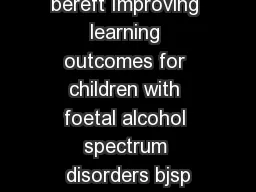

43 Barry Carpenter Foetal alcohol spectrum disorder FASD is the most common nongenetic cause of learning dis ability affecting around 1 of live births in Europe and costing an estimated 29 million per individual across their lifespan In adulthood non ID: 38345
Download Pdf The PPT/PDF document "Pedagogically bereft Improving learning ..." is the property of its rightful owner. Permission is granted to download and print the materials on this web site for personal, non-commercial use only, and to display it on your personal computer provided you do not modify the materials and that you retain all copyright notices contained in the materials. By downloading content from our website, you accept the terms of this agreement.
Pedagogicallybereft!Improvinglearningoutcomesforchildrenwithfoetalalcoholspectrumdisorders bjsp_49537..43 BarryCarpenter Foetalalcoholspectrumdisorder(FASD)isthemostcommonnon-geneticcauseoflearningdis-ability,affectingaround1%oflivebirthsinEurope,andcostinganestimated$2.9millionperindividualacrosstheirlifespan.Inadulthood,non-reversiblebraindamageisoftencompoundedbysecondarydisabilitiesinadulthood,suchasmentalhealthproblemsanddrugaddiction.Thechallengefortodayseducatorsis:HowdoweteachchildrenwithFASD?Theirunusualstyleoflearningandtheirextremechallengingbehaviourisoutoftheexperienceofmanyteachers.Thisarticle,writtenbyProfessorBarryCarpenter,OBE,NationalDirec-toroftheSpecialistSchools&AcademiesTrustComplexLearningDif cultiesandDisabilitiesResearchProject,considersthestatusofFASDintheUK,andprovidesanoverviewoftheauthorsrecentresearchintoeffectiveeducationalstrategieswithintheframeworkofEveryChildMatters.Onlygovernment-ledapproachescanleadtoimprove-mentsinthequalityofteachingandlearningforchildrenwithFASDandtheirfuturelifechances.Keywords:foetalalcoholspectrumdisorder,EveryChildMatters,educationalstrategies.IntroductionFoetalalcoholspectrumdisorder(FASD)isthemostcommonpreventablecauseoflearningdisability/difÞcultyintheUK.ThisspectrumdisorderincludeschildrenwithÔfullblownÕfoetalalcoholsyndrome(FAS)whodisplaydistinctivecraniofacialabnormalities,smallheadcircumfer-enceandgrowthdifÞculties.Themostobviousindicatorsareasmallhead,epicanthalfoldsaroundtheeyesandanindistinctphiltrumfromthenosedowntoanoftenthinupperlip(Astley&Clarren,2000)(seeFigure1).Thesechildrentypicallydisplayintellectualimpairment(Mukher-jee,2004).However,additionalalcohol-relatedbirthdefects FOCUSONPRACTICE ©2011TheAuthor.BritishJournalofSpecialEducation©2011NASEN.PublishedbyBlackwellPublishingLtd,9600GarsingtonRoad,OxfordOX42DQ,UKand350MainStreet,Malden,MA02148,USA.DOI:10.1111/j.1467-8578.2011.00495.x heavilywhilepregnantgavebirthtounderweightinfantswithdistinctfacialfeatures,cognitivedelaysandchalleng-ingbehaviour.Themostwidelyreportedstudies,however,arethoseofJonesandSmith(1973)publishedin,inwhichtheyÞrstcoinedthetermÔfetalalcoholPrevalenceratesofFASrangefromoneper1,000inrela-tivelylow-riskpopulations,throughfourper1,000inmoderate-riskpopulations,toratesof40per1,000incertainveryhigh-riskSouthAfricancommunities(Molteno,2008).InFrance,theprevalenceisestimatedatonein330,asitisinGermany;inSweden,theestimatesareonein600,and,intheUS,onein1,000.AlcoholhashadanextremelydestructiveeffectonindigenouspopulationssuchasMaoris,AboriginesandNativeAmericans,whereFASisreportedinonein170livebirths(Golden,2005).Inmostwesterncountries,thecurrentestimatesofFASDprevalenceare1%ofthechildpopulation(Sampson,Streissguth,Bookstein,Little,Clarren,Dehaene,Hanson&Graham,1997).ArecentsigniÞcantstudyhasbeenthatconductedbyacombinedUSandItalianteamintheLazioregionofItaly(May,Fiorentino,Gossage,Kalberg,Hoyme,Robinson,Coriale,Jones,delCampo,Tarani,Romeo,Kodituwakku,Deiana,Buckley&Ceccanti,2006).Typically,inItaly,mod-eratealcoholconsumptionisintegratedintoeverydaylifeaspartofthesocialactivityofsharingmealstogether.Italianwomenarenotknownasbingedrinkers,comparedtosomeoftheirEuropeancounterparts,andthusthisstudysoughttoascertainifmild,consistentconsumptionwouldcausehighlevelsofdamagetounborninfants.Theratesoffull-blownFASwere3.7Ð7.4per1,000children,andforFASD,20.3Ð40.5per1,000,whichwerehigh.TheauthorsstatethatÔoverall,therateofFASDinthisWesternEuropeanpopu-lationmaybe3.5%Õ.ItisclearthatFASDismultifactorial(Autti-Ramo,2002).Invariousstudies,thewomeninterviewedwerenotonlycon-suminglargeamountsofalcohol,butwerealsosmokingandusingdrugs.SocialcircumstanceswerealsoafactorÐwomenlivinginpovertywerefoundtobemorepronetobingedrinkingÐandtherewerethosewomentoowhosegeneticpredispositioncontributedtotheimpactofalcoholonthefoetus(R.Gray,personalcommunication,NovemberCanadianresearchhasshownthatmanychildrenwithFASDareinitiallymisdiagnosedwithautisticspectrumdisorder(ASD),AspergerÕssyndrome(AS),attentiondeÞcit/hyperactivitydisorder(AD/HD)andobsessivecompulsivedisorder(OCD)(OÕMalley,2007).FASDencompassesdeÞ-citsinlearning,attention,memoryandjudgement.Individu-alswithFASDareoftenmisdiagnosedduetoassessmentoutcomesfocusingontheirbehaviours,ratherthanthealcohol-causedbraindamage(Streissguth,Barr,Kogan&Bookstein,1996).Australianstudieshavereportedthisasaparticularlyneglectedgroupofchildrenwhoareover-representedincertainpopulationgroups.Forexample,itisestimatedthatasmanyas85%ofchildrenwithFASDendupinthefostercaresystem.Asthesechildrengrow,theyoftenexperiencepoormentalhealth.Theymaybecomehomelessandchroni-callyunemployed,andmanydonotcompletecompulsoryeducation.Again,itisreportedthatmanyyoungpeoplewithFASDwillhaveearlyentryintothecriminaljusticesystem,andwithoutinterventionwillbecomeÔrevolvingdoorpris-onersÕ(S.Meier,personalcommunication,2008).ThechallengeWhateverthebackground,thechallengeremains:howdoweoptimiselearningforthispupilgroup?Evenmoreso,wehavetoask,howdoweteachthem?DespitetheattentiongiventodiagnosingFASanddescribingthechildrenÕschar-acteristics,therehasbeennosystematicinvestigationoftheeducationalneedsofchildrenwithFASDoronbesteduca-tionalstrategiesforeffectiveteachingandlearning(Ryan&Ferguson,2006).Oftenteachers,beingunawareofthisgroupofchildren,donotidentifythemorplanspeciÞcallytomeettheirlearningneeds.Untilrecently,therewasnodirectguidancefromanygov-ernmentagencyintheUKtoteachersonhowtoeducatechildrenwithFASD.However,inOctober2010,NOFAS-UK(www.nofas-uk.org)publishedasigniÞcantreportofferingguidancetoteachersinallagephases(Black-burn,2010).Thethree,major,parent-ledorganisationsintheUK,NOFAS-UK,theFASDTrust(www.fasdtrust.co.uk)andFASAware(www.fasaware.co.uk),doprovidesomeguidance,butitisinneedoffurtherdevelopmentanddirec-tioninthecurrentUKcurriculumframework.IncountriessuchasCanadaandtheUS,thereisextensiveguidanceandawell-developedsystemofprovisionforthesechildren.Thereisagreateducationalvulnerabilityaroundthesechil-dren,whichmeansthatthecurrentstyleandstructureofmanyclassroomsisnotconducivetoengagingthemaseffectivelearners.Manyoftheirbehaviouraltraitsmilitateagainstsustainedlearningwithcumulativegains.Asonemother,JuliaBrown,thefounderoftheFASDTrust,stated:Itslikelivingwithsomeonewhoisdrunk.Theyareclumsy,suffermemoryloss,anddisplaysociallyinappropriatebehaviour.Theythinktheyareinvincible:thattheyareSupermanandcan y!IfaformalidentiÞcationofachildwithFASDhasnottakenplaceintheearlyyears,thenitisoftenatschoolthatspeciÞcconcernsareraisedfortheÞrsttime.BraindamageisthemostseriousaspectofFASD(seeFigure2).Thisdamageispermanent.Itcanbeaccommodated,butnotreversed.FASDaffectscognition,behaviourandsocialskills.Itisaperva-sivedevelopmentaldisorderwithlifelongimplicationsforschoolingandbeyond.WhereasthefacialfeaturesofthechildwithFASmakeiteasiertodetect,forthoseelsewhereonthespectrum,iftheydonothavethesefacialfeatures,thenitisusuallytheintensityoftheschoollearningsituationwhichhighlightstheirparticularneeds. 38BritishJournalofSpecialEducation·Volume38·Number1·2011©2011TheAuthor.BritishJournalofSpecialEducation©2011NASEN ManyUKschoolsettingswillnotbeawarethattheyhavechildrenwithFASDintheirpupilpopulationÐtheymaybepresent,butwiththealternativediagnosesdescribedabove.Classroomaccommodation,adaptationandameliorationarerequiredtoengagechildrenwithFASDaseffectivelearners.ThedevelopmentalproÞleofchildrenwithFASDisvari-able.Theirexpressivelanguagemaybeinadvanceoftheiractualage,andtheirreadingskillsmaybechronologicallyappropriate.However,inareassuchassocialskillsandemotionalmaturity,theymaybeperformingathalfoftheirdevelopmentalage.Mathematicalandnumericalconceptsareparticularlychallengingforthisgroupofchildreninthat,forsome,theparietallobe,whichcontrolsnumeracyandcomputationalactivityinthebrain,mayhavesigniÞcantlyreducedfunctioning(Kopera-Frye,Dehaene&Streissguth,1996).ThismeansthatchildrenwithFASDaredifÞculttoaccommodatewithinanyKeyStageoftheEnglishNationalCurriculum.Sadly,therootcauseofthechildrenÕsproblemsrelatestothealcoholdamagesufferedduringpregnancy.Thisisaparticu-larissueintheUK.AsRiley(2007)hasstated:ÔBingedrinking,whichissocommonintheUK,isparticularlyharmfultothedevelopingbaby.Damagetothebrainisthemostdevastating,andcanoccuratanypointduringpregnancy.ÕIdentifyinglearningneedsIn2008,theauthorcarriedoutapreliminarypieceofquali-tativeresearch,seekingtoexploresomeexistingeducationalpracticeconcerningFASDintheWestMidlandsÐwhatteachershadidentiÞedasthekeylearningissuesforthesechildrenintheirclassrooms,andwhattheireffectiveteach-ingstrategieswere.Thepurposivesamplecomprised20teachersinprimary,secondaryandspecialschools,allofwhomwerecurrentlyworkingwithachildwithadiagnosisofFASDorhadworkedwithsuchachildwithintheprevi-oustwoyears.Informationwasgatheredthroughsemi-structuredinterviewswithteachersand,wherepossible,thestudentsthemselves,andthroughdirect,periodic,non-participantobservationsofteachersandchildreninclass-roomenvironments.Inthesemi-structuredinterviews,teacherswereaskedtoidentifythechallengestotheclassroomlearningenviron-mentpresentedbythechildren.Thefollowingisalistofthetop10challengesreportedbytheseteachers:1.hyperactivity;2.shortattentionspan;3.erraticmoodswings;4.poormemory;5.lackofsocialskills;6.auditory/vocalprocessing;7.visualsequencing;8.sensoryintegrationdifÞculties(particularlylackof9.poorretentionoftaskinstruction;10.numeracy/mathematicaldifÞculties.ItwasveryobviousthatretentionandoverlearningwerenotkeyfeaturesofthelearningpatternofthechildwithFASD.Asoneteachersaid,Itsverymuchheretoday,gonetomorrow!RegardlessofthedifÞcultiesidentiÞed,howweoptimisethelearningofthesechildrenremainsthechallenge.Theobser-vationsofchildrenwithFASDinclass,alongsideanexten-siveinternationalliteraturesurveywhichreportedteachingchildrenwithFASD,ledtotheidentiÞcationof10majorteachingresponsestothe10learningneedsproÞledabove.Thesewere:1.acalmlearningenvironment,freefromclutter;2.focusedtaskspresentedinsmallsteps;3.personalspaceforthestudentwithplentyofsupportandpraise;4.visualstructuring;5.scripting/roleplay;6.short,keyinformation-carryingwordinstructions;7.visualclarityandgraphicsimplicity;8.frequent,shortexerciseprogrammesduringtheday;9.abreakdownoftaskswithvisualandtactileclues,andtimegivenforthechildtocompletethetask;10.multisensorylearningÐgivingmessagesthroughavarietyofsensorypathways.AsonestudentwithFASDsaid:Whenateacherusesvisualclues,Icanunderstandthetopic.Ilearnbetterwhenthingsarepresentedinavisualway.Mybraindoesnotalwayscopewiththewordstheteachersays.Iwouldsaytoteachers,Pleaseshowme,donttellme....Figure2:ComparisonofbrainofnormalbabywithbrainofbabywithFASThephotographontherightshowsanexampleofextremealcoholdamagetothebrainofababywithFAS.Aswiththisbaby,thosewhohavethisdegreeofdamageareunlikelytosurviveintoinfancy.Photo:SterlingClarren,MD. ©2011TheAuthor.BritishJournalofSpecialEducation©2011NASENBritishJournalofSpecialEducation·Volume38·Number1·201139 ManagingthechildwithFASDintheclassroomenvironmentObservationsindicatedthatthestructureoftheclassroomwasabsolutelykeytohowchildrenwithFASDfunctionedintheirlearningenvironment.Whereteachershadcarefullyconsideredphysicalstructure,deploymentofstafÞng,visu-allybasedresources,groupingsofchildrenandtheirteach-ingstyles,thenthelevelsofengagementforthesechildrenwereconsiderablyhighertheninclassroomswherethisdidnothappen.DiscussionswithteachersshowedthatwhenconsideringtheseÞvepoints,inrelationtophysicalstruc-ture,theyhadthoughtthroughthelightingoftheclassroom,creatingdistraction-freeenvironments,andanysensitivitytocolourthatthechildmayshow.Forexample,whendeploy-ingstafftheyknewthatMathematicswasaparticularlychallengingcurriculumareaforthechildandthereforeensuredthatateachingassistantwasavailabletosupportthechildwithFASDduringthesesessions.AsmanualdexterityisnotastrengthofchildrenwithFASD,pencilholderswereprovided.Inordertostrengthenvisuallearning,visualclutterontableswaskepttoanabsoluteminimum.Peergroupingswereinevitablythemajorproblemarea.ThechildwithFASDisoftenirrational,yetlongsforfriendships.TenteachersreportedthattheyhadtriedÔbuddysystemsÕ,but,inseveralinstances,thishadledtothebuddyactuallybeingphysicallyorverballyabusedbythechildwithFASD.Mostteachersadoptedarotationalsystem,wherethechildwithFASDjoineddifferentgroupsfordifferentcurriculumareas.Thiswaseasiertoachieveinthesecondaryschoolcontextthanintheprimaryschoolcontext.AnoverridingmessageinrelationtoteachingstaffisthatthechildwithFASDisavisuallydominantlearnerÐnotinthesamepronouncedwayasthechildwithASD,buttheirvisualprocessingwascertainlymoreefÞcientthantheirauditory/vocalprocessing.TheseteacherinterventionstomediatethelearningenvironmentmirrortheadviceofferedbyKleinfeldandWestcott(1993)formanagingthechildwithFASDintheclassroom.Theysuggest:seatingthechildatthefrontoftheclassroom,alwaysinthesameseat;minimisingdistractions;providingacalmspace;ensuringvisuallycleardisplay;usingtapeontheßoortodeÞnespatialboundaries;keepingtheclassroomdoorclosed;closingblindspartially(ifbrightlight);avoidingbells.Inarecentstudy,Blackburn,CarpenterandEgerton(2010,p.143)state:ÔSupportandeducationforchildrenwithfoetalalcoholspectrumdisordersarebestdirectedatthechildÕsindividualpointoflearningneedÕ.Fromtheirstudy,theyidentiÞedthatthemainstrategiesforworkingwithchildrenandyoungpeoplewithFASDwere:clear,concrete,simplelanguagebackedupwithvisualclues;consistencywithlanguage,rewardsandroutines;beingpreparedtorepeatinstructionsandrules;implementingandstickingtoaroutine;providingstructureandconstantsupervision;employingadaptiveteachingtechniqueswhichfocusuponthechildÕsinterests,strengthsanddevelopmentalstage.DuetolackofspeciÞcguidance,severalteachershadinventedtheirownstartingpointsforeducatingthechildwithFASD,andoftenborrowedfromtheworldofASD.Thereweremanyexamplesofteachersusingsocialstories(Gray&White,2002).ThistechniquewasextendedbytheresearcherintoÔscriptingÕwherebychildrenweregivenopportunitiestoroleplayforthcomingsituationsthattheywouldencounterandrehearsetheactionsandlanguagethattheymayhavetouseinthosesituations.Forexample,a10-year-oldwithFASDwasabouttousethelocalshoptohelphismother.Ascriptwasdevisedforhimwherebyhecouldpractisetheexchangeofmoneyforaselectionofgoodsandthelanguagetobeusedinmakingthepurchases.ThisensuredthatwhenhewenttotheshopindependentlyfortheÞrsttime,hischanceofsuccesswasmuchhigherthanifhehadnotbeenprepared.ManychildrenwithFASDmayappearclumsyandimpul-sive,cravinghigh-intensitymovement.Yetwhentheydoengageinmovementactivities,theirhandÐeyeco-ordinationisoftennotwelldeveloped,andtheydisplayaninappropri-ateuseofphysicalforce.InherexcellentguidanceforworkingwithyoungchildrenwithFASDintheearlyyears,ÔBuildingbridgeswithunderstandingÕ,Blackburn(2009)advisestheuseofÔÞdgetitemsÕ(forexample,astressball,kooshball,beanbag,spiralshoelaceorspiralkeyring)tofocusthechildÕsneedtomoveconstantlyandalsotoimprovetheirconcentration.CertainlymanyteachersfoundthatprovidingchildrenwiththeopportunityforregularshortburstsofactivitywasaneffectivewayofaddressingtheinappropriatemovementsandphysicalhyperactivitythechildwithFASDmayotherwisedisplay.ManychildrenwithFASDbeneÞtfromtheinterventionofanoccupationaltherapistwhocandeviseasensory-integrationprogramme.Withinthecurriculum,itismorethanwhatteacherscom-monlyunderstandtobePE!Focused,taughtmovementscansupportbraindevelopment(Carpenter,2007).ManagingthechildwithFASDintheclassroomenvironmentTheerraticlearningpatternofthechildwithFASDmeantthatmanyteachersfounditdifÞculttoplanlearningactivitiesforthechild.Basedonadifferentiatedmodelofcurriculumplanning(Carpenter,Ashdown&Bovair,2001),aplanningmodelwasevolvedwhichincludedacore,extensionandsupportactivity.ThepurposeofthiswasfortheteachertobeabletopitchthelearningforthedaydependinguponthechildÕsmoodandattitudetolearning.Ifthechildwaspar-ticularlydistractedoremotionallyvolatile,thenthesupportactivitycouldbeimplemented,butiftheywerecalmandengaged,thentheextensionactivitycouldbeused.Thisapproachpreventedthechildrenfrombecomingcompletelydisengagedfromlearning,andensuredtheywerelessdisrup-tiveintheclassroomenvironment(OÕBrien&Guiney,2001). 40BritishJournalofSpecialEducation·Volume38·Number1·2011©2011TheAuthor.BritishJournalofSpecialEducation©2011NASEN Thedescriptionofthecoreactivityalwaysarticulatedthecentralskillsthatwouldbeacquired,andthesupportactivityinvolvedadimensionofthecorelearningtaskthatpromotedself-imageandthereinforcingofsuccessthroughachieve-ment.Theactivitywasdesignedtobesimplerandtolinktoearlierlearning.Theextensionactivitywasaparallelactiv-ityreinforcingthesamecoreskillsbutinadifferentform,andenabledthechildtoexploreaspectsofthecoreactivity,butofteninshortburstsduetotheirlimitedconcentrationManyofthechildrenobservedinthisstudyparticularlyenjoyedactivitiesthatfocusedonthemselves.Aparticularlygoodexampledevelopedbyoneteacherwasapersonallearningplanwhichwasusedveryeffectivelytoremindthechildoftheirowngoalsandthesuccessesthattheyhadachieved.Thisplanwaslistedas:meandmyfutureÐtheirdreamsandaspirations;mysupportÐwhatphysicalresourceswereavailableintheclassroomtoassistthechild;myprogressÐtherewasaperformancechartloggingthechildÕsprogress;mysubjectsÐthisdescribedsomeofthekeylearningactivitiesthechildcouldenjoyineachsubjectmygoalsÐtheseweregoalssetbythechildthemselvesasstepstoimproveandraisetheirmybestworkÐevidenceoftheirsuccessshowcasedintheirworkfolder.Theplanwasdesignedusingdigitalphotographs,visualsymbolsandboldtext.Oftenwhenthechildwasverywith-drawnorlackinginself-esteem,itwouldbeusedtoremindthemhowsuccessfultheyhadbeenattimes,andhelpthemlooktowhattheirfutureachievementsmaybe.UnderstandingthelearnerwithFASDChildrenwithFASDareveryerraticandunpredictablelearners,anditisnecessarytoreframeourtraditionalexpec-tations.Strategiesadoptedmusttakeintoconsiderationneu-rologicaldifferences.DuetotheirsensoryprocessingdifÞculties,weneedtoconsiderhowchildrenwithFASDmakesenseof,anduseof,informationfromthesensoryworld(Jirikowic,2007).ChildrenwithFASDoftenover-react,eventosimplethingslikeaßylandingnearthem.Theymaystartleifsomeoneapproachesthemfrombehind.Theymaybedriventoseekoravoidcertainsensations.ThereisalsosigniÞcantemotionaldysregulationinchildrenwithFASD,andtheyarepronetosigniÞcantmoodswings.Theircapacityforself-regulationisimpaired;theyÞnditdifÞculttoself-calm,andseemnottorespondwelltoparen-talcalmingtechniquessuchashugging.Classroomshavetobecarefullydesignedtoaccommodatetheirlearningandbehaviouralneeds.SomeprimaryteachersinthisstudyhaddevelopedÔsafeareasÕintheirclassrooms,providingaper-sonalspaceforthechildwithFASD,containingcushionsandfavouritetoys/activitiesknowntohaveacalmingeffect.EveryChildMattersItwouldbeeasytocreateawholepedagogyaroundthechildwithFASD,butinthecontextofinclusiveeducation,itisbettertoseektoblendtheirlearningstylesintoinclusiveclassroomsettings.Inthisstudy,thelearningneedsofthechildwithFASD,andtheteachingresponsetothatneed,weresetwithinthecontextoftheÞveoutcomesofChildMatters.Forexample:behealthyÐaprogrammeoffocusedexercisetomoderatethechildÕshyperkinetictraits,aimedatself-motivationandself-regulation;staysafeÐsocialstoriestoaddressthechildÕslackofenvironmentalawarenessortoexploreandexplainvarioussocialsituations,potentialdangers,andhowtokeeppersonallysafe;enjoyandachieveÐvisualpresentationoftasksandover-learningroutinestosupportlearningcontinuityandretention;makeapositivecontributionÐanadaptedenvironment,toincludetheuseofspeciÞc,visuallysupportedinstructions,socialstoriesandapersonalspaceforthechildtowithdrawto,whichreducesinstancesofpersonalfrustrationleadingtolossofself-controlandsubsequentembarrassment;achieveeconomicwell-beingÐgivethechildconcreteexperiencesoftime,number,space,money,etc.,whichmayovercometheirmathematicalchallenge.ThefutureforpeoplewithFASDFASDcoststheUS$36billiondollarsperyear,andthetotallifetimecostofanindividualwithFAStosocietyisesti-matedat$2.9million(Peadonetal.,2008).Thelong-termcostsofFASDimpactonhealthcare,residentialservices,disabilityservices,housing,socialservices,adultvocationalservices,sexualhealthcounsellingandsupportservices.YoungpeoplelivingwithundetectedandundiagnosedFASDwilloftenenterthecriminaljusticesystemandwithoutinterventionwillbecomelong-termprisoners.ThelifelongimplicationsofFASDareoftencompoundedbysecondarydisabilitiesinadulthoodsuchasmentalhealthproblemsanddrugaddiction.MentalhealthproblemsmayescalateduringadulthoodÐ23%ofadultswithFASDhaveattemptedsuicide,whileasmanyas43%haveconsideredit(Huggins,Grant,OÕMalley&Streissguth,2008).Inparticular,friendshipsareproblematicforpeoplewithFASD,and,inadulthood,theyÞndthemselvessociallyiso-latedandexcludedfrommanycommunity-basedpro-grammesduetotheirinabilitytosustainfriendships,initiatesociallyappropriatepeerinteractionortocementandsecurefriendshipbonds(Streissguth&Kanter,1997).(ThisisapatternalsoreportedbyTaylorandHoughton(2008)inarecenteditionoftheBritishJournalofSpecialEducationchildrenwithAD/HD,againunderscoringtheinterfacebetweenthesetwodisablingconditions.)ThereisclearlyasigniÞcantshortfallinguidanceforteach-ersonhowtoeducatechildrenwithFASDintheUK.Yet ©2011TheAuthor.BritishJournalofSpecialEducation©2011NASENBritishJournalofSpecialEducation·Volume38·Number1·201141 FASDnowaccountsforthelargest,non-geneticgroupofchildrenpresentingwithlearningdifÞculties/disabilities.TheirdifÞcultiesepitomisethatmuch-usedphrase,ÔcomplexneedsÕ.Theirunusualstyleoflearningandtheirextremechallengingbehaviourisoutoftheexperienceofmanyteachers,andthereforetheyÞndthemselves,asthetitleofthisarticlesays,ÔpedagogicallybereftÕ.Throughteacherinterview,classroomobservationandlitera-turesearch,theresearchstudydescribedaboveattemptedtooffersomestructuretotheprocessofteachingandlearning,andtoprovidesomeevidence-basedsuggestionsforhowchildrenwithFASDmaymeetthatmajortwenty-Þrst-centurychallenge,engagement.Thereismuchyettobedone,andtheonlywaythattherewillbesigniÞcantimprovementsinthequalityofteachingandlearningforthesechildrenisthroughagovernment-ledinitiativetoaddresstheneedsofthissorelyneglectedpupilgroup.TheneedsofthesechildrenhavetobesetintothewidercontextofsocietyÕsdebateaboutalcohol,forwithoutsuchadebatethenumbersofchildrenwithFASDwillgrowyearonyear.TheChildrensPlan:OneYearOn(DeÞneResearch&Insight,2008)launchedtheYouthAlcoholPlan,whichiscommittedtoahard-hittingcampaigntomakeyoungpeoplethinkabouttheconsequencesofdrinkingtoomuchalcohol.Asasociety,weÞnddiscussionsaroundalcoholconsump-tiondifÞcult.TheDCSFÕsstudy(DCSF,2008)ontheuseofalcoholamongchildrenandyoungpeoplehasacknowl-edgedthatthecausalmythoftheÔageoftheÞrstdrinkÕisahugeobstacletoovercome.Fromallprofessionalsectorsthatareawareofthisproblem,wearehearingpleastorecognisethescaleoftheproblem.IntheBritishJournalofPsychiatry,GuptaandWarner(2008)haverecentlystatedthatÔanunrecognised,alcohol-relateddementiatimebombisfacingyoungdrinkersÕ.Gilmore(2009),report-ingfortheRoyalSocietyofPhysicians,hasstatedthat:ÔTheyoungertheydrink,themorelikelytheyaretohavealcohol-relatedproblemslaterinlife.Itisnowcommontoseeyoungmenandwomenintheirearly20swithend-stagealcoholliverdamage.ÕOnesocialcommentator,Sigman(2008),haspointedoutthatÔWhenitcomestoourlogicregardingintroducingchil-drentoalcohol,weseemtothinkingundertheinßuenceofthedevilÕsbuttermilk.ÕThesesocietaldebatesarenecessaryifwearetopreventarapidescalationbeyondthecurrenthighlevelsofFASDintheUK.FASDscanbeespeciallyhardforfamiliesbecausetheyareÔinvisibleÕdisordersthatshowupprimarilyasbehaviourandlearningproblems(Olson&Astley,2007).WeonlyhavetolistentotheprofoundwordsofElizabethRussell,amotheroftwosonswithFASD,torealisehowpeoplewishthattheyhadbeengivenappropriatewarningsuponwhichtheycouldhavebasedeffectivepersonalchoicesÐnotonlyforthemselves,butalsofortheiroffspring:Ifmyson,Micks,paediatricianhadenquiredaboutmyalcoholintakewhenhediagnosedMickatsixmonthsofageaspossiblyretarded,Seth(myotherson)wouldnotnowhaveFetalAlcoholSyndrome.Wewouldhavetworelativelyhealthychildreninwhosefuturewaswoventhethreadofpeaceandcontentment,notfearandapprehension,andIwouldneveragainhavetolookatmysonsterri edeyeshidingbehindamake-believesmile.(www.rffada.org)However,today,theyarenotthemajorconcernoftheclass-roomteacher.Forthem,itisthechallengeofthechildwithFASDwhofacesthem:howarethelearningneedsofthischildtobemet;isthereresponsivityinthecurriculum;dowehavethecapacitytoevolveteachingstrategiesthatwilltouchthatchildwithFASDathisorherpointoflearningneed? ReferencesAstley,S.&Clarren,S.(2000)ÔDiagnosingthefullspectrumoffetalalcoholexposedindividuals:introducingthe4-digitdiagnosticcodeÕ,Alcoholand,35,400Ð410.Autti-Ramo,I.(2002)ÔFoetalalcoholsyndrome:amultifacetedconditionÕ,DevelopmentalMedicine&ChildNeurology,44,141Ð144.Blackburn,C.(2009)ÔBuildingbridgeswithunderstandingproject:foetalalcoholspectrumdisorderÐfocusonstrategiesÕ[onlineatwww.worcestershire.gov.uk/eycs].Blackburn,C.(2010)FacingtheChallengeandShapingtheFutureofPrimaryandSecondaryAgedStudentswithFoetalAlcoholSpectrumDisorders.London:NOFAS-UK[onlineatwww.nofas-uk.org].Blackburn,C.,Carpenter,B.&Egerton,J.(2010)ÔShapingthefutureforchildrenwithfoetalalcoholspectrumdisordersÕ,SupportforLearning,25(3),Carpenter,B.(2007)ÔMovingforwardÕ,inE.MarsdenandJ.Egerton(eds)MovingwithResearch:Evidence-basedpracticeinSherborneDevelopmentalMovement.Clent:SunÞeldPublications.Carpenter,B.,Ashdown,R.&Bovair,K.(2001)EnablingAccess:effectiveteachingandlearningforchildrenwithlearningdif culties.London:DavidFulton.DCSF(DepartmentforChildren,SchoolsandFamilies)TheChildrensPlan:oneyearon[onlineathttp://www.dcsf.gov.uk/oneyearon/ae/uploads/DeÞneResearch&Insight(2008)UseofAlcoholamongChildrenandYoungPeople(DCSF-RW043): nalreport.London:DCSF[onlineathttp://publications.dcsf.gov.uk/eOrderingDownload/DCSF-RW043.pdf]. 42BritishJournalofSpecialEducation·Volume38·Number1·2011©2011TheAuthor.BritishJournalofSpecialEducation©2011NASEN Gilmore,I.(2009)ÔTheyoungertheydrinkÕ.InauguraladdresstotheFoetalAlcoholForum,HouseofLords,January2009.Golden,J.L.(2005)MessageinaBottle:themakingoffetalalcoholsyndrome.Cambridge,MA:HarvardUniversityPress.Gray,C.&White,A.(2002)MySocialStoryBookLondon:JessicaKingsley.Gupta,S.&Warner,J.(2008)ÔAlcohol-relateddementia:a21st-centurysilentepidemicÕ,BritishJournalofPsychiatry,12(6),114Ð121.Huggins,J.E.,Grant,T.,OÕMalley,K.&Streissguth,A.P.(2008)ÔSuicideattemptsamongadultswithfetalalcoholspectrumdisorders:clinicalconsiderationsÕ,MentalHealthAspectsofDevelopmentalDisabilitiesAprilÐJune2008[onlineathttp://Þndarticles.com/p/articles/mi_6883/is_2_11/ai_n28524972/Jirikowic,T.(2007)ÔSensoryintegrationandsensoryprocessingdisordersÕ,inK.D.OÕMalley(ed.)andFetalAlcoholSpectrumDisorders.NewYork,NY:NovaSciencePublishers.Jones,K.L.&Smith,D.W.(1973)ÔRecognitionofthefetalalcoholsyndromeinearlyinfancyÕ,(836),999Ð1001.Kleinfeld,J.&Westcott,S.(eds)(1993)FantasticAntoneSucceeds:experiencesineducatingchildrenwithfetalalcoholsyndrome.Fairbanks:UniversityofAlaskaKopera-Frye,K.,Dehaene,S.&Streissguth,A.P.(1996)ÔImpairmentsinnumber-processinginducedbyprenatalalcoholexposureÕ,Neuropsychologia,34,1187Ð1196.Lemoine,P.,Harousseau,H.,Borteyrun,J.P.&Menuet,J.C.(1968)ÔLesenfantsdeparentsalcooliques:anomaliesobservesproposde127casÕ,,21,476Ð482.May,P.A.,Fiorentino,D.,Gossage,P.J.,Kalberg,W.O.,Hoyme,E.H.,Robinson,L.K.,Coriale,G.,Jones,K.L.,delCampo,M.,Tarani,L.,Romeo,M.,Kodituwakku,P.W.,Deiana,L.,Buckley,D.&Ceccanti,M.(2006)ÔEpidemiologyofFASDinaprovinceinItaly:prevalenceandcharacteristicsofchildreninarandomsampleofschoolsÕ,ClinicalandExperimentalResearch,30(9),1562Ð1575.Molteno,C.(2008)ÔFoetalalcoholspectrumdisorderÕ,JournalofIntellectualDisabilityResearch,52(8),640.Mukherjee,R.(2004)FoetalAlcoholSyndrome:anoverviewoftheliterature.London:StGeorgeÕsHospitalMedicalSchool.OÕBrien,T.&Guiney,D.(2001)DifferentiationinTeachingandLearning:principlesandpracticeLondon:ContinuumPress.OÕLeary,C.,Heuzenvoeder,L.,Elliott,E.J.&Bower,C.(2007)ÔAreviewofpoliciesonalcoholuseduringpregnancyinAustraliaandotherEnglish-speakingMedicalJournalofAustralia,188(9),OÕMalley,K.D.(ed.)(2007)ADHDandFetalAlcoholSpectrumDisorders.NewYork,NY:NovaSciencePublishers.Olson,H.C.&Astley,S.(2007)ÔHelpingfamiliesraisechildrenwithfetalalcoholsyndromedisordersÕ,,18(2),3Ð5.Peadon,E.,Freemantle,E.,Bower,C.&Elliott,E.J.(2008)ÔInternationalsurveyofdiagnosticservicesforchildrenwithFASDÕ,BMCPaediatrics,8(12),1Ð8.Riley,E.(2007)ÔTheneurodevelopmentalbrainÕ.LecturetotheConferenceÔConsequencesforchildrenaffectedbymaternaldrugandalcoholusageÕ,ShefÞeld,May.Ryan,S.&Ferguson,D.L.(2006)ÔOn,yetunder,theradar:studentswithfetalalcoholspectrumdisorderÕ,ExceptionalChildren,72(3),363Ð365.Sampson,P.D.,Streissguth,A.P.,Bookstein,F.L.,Little,R.E.,Clarren,S.K.,Dehaene,P.,Hanson,J.W.&Graham,J.M.(1997)ÔIncidenceoffetalalcoholsyndromeandprevalenceofalcohol-relatedneurodevelopmentaldisorderÕ,Teratology,53,Sigman,A.(2008)ÔDangerousmeasuresÕ,TimesEducationalSupplement,26December.Streissguth,A.&Kanter,J.(eds)(1997)TheChallengeofFetalAlcoholSyndrome:overcomingsecondarydisabilities.Washington,DC:UniversityofWashingtonStreissguth,A.P.&Little,R.E.(1994)ÔUnit5:alcohol,pregnancy,andfetalalcoholsyndrome(2ndedn)Õ,ProjectCorkInstituteMedicalSchoolCurriculum(slidelectureseries)onBiomedicalEducation:AlcoholUseandItsMedicalConsequences.Timonium,MD:Milner-Fenwick/DartmouthMedicalSchool.Streissguth,A.,Barr,H.,Kogan,J.&Bookstein,F.(1996)ÔUnderstandingtheoccurrenceofsecondarydisabilitiesinclientswithfetalalcoholsyndrome(FAS)andfetalalcoholeffectsÕ.FAE.FinalReport:CentersforDiseaseControlandPreventionGrantNo.04/CCR008515.Seattle,WA:UniversityofWashingtonFetalAlcoholandDrugUnit.Taylor,M.&Houghton,S.(2008)ÔDifÞcultiesininitiatingandsustainingpeerfriendships:perspectivesonstudentsdiagnosedwithAD/HDÕ,BritishJournalofSpecialEducation,35(4),209Ð219. Addressforcorrespondence:Prof.BarryCarpenter,OBEComplexLearningDifÞcultiesandDisabilitiesResearchSpecialistSchools&AcademiesTrustWolverhamptonScienceParkTechnologyCentreGlaisherDriveWolverhamptonWV109RUEmail:barry.carpenter@ssatrust.org.ukArticlesubmitted:June2009Acceptedforpublication:September2010 ©2011TheAuthor.BritishJournalofSpecialEducation©2011NASENBritishJournalofSpecialEducation·Volume38·Number1·201143